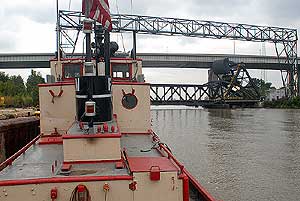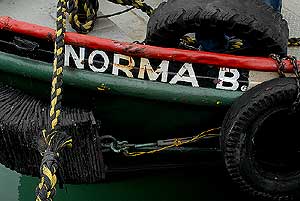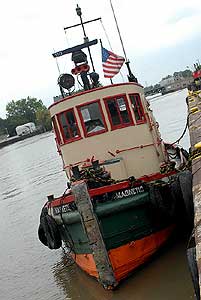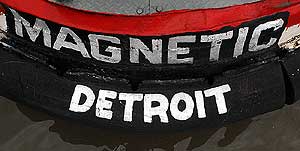His Personal Walden
The
mouth of the Rouge River may not be your ideal place for soul-searching
serenity, but don’t tell that to Southwest Detroit tugboat captain Wade
Streeter.
The siren song of the sea has been the inspiration for countless odes.
While many are romanced by the cathedral chant of underwater diving or
by the salty sailor’s shanty, it takes a particular breed to catch the
singular tune carried by the workhorse of the water: the tugboat.
Wade
Streeter heard it a long time ago. He is a tugboat captain, and partner
in Ferriss Marine Contracting located in the Del Ray neighborhood of
Southwest Detroit. He fusses over his tugs, the Magnetic and the Norma
B., like a proud father, annually painting them Ferriss’ signature
colors of red, green and taupe and photographing them incessantly. He’s
one of those guys you just immediately know loves his job.
 Streeter
Streeter
caught the tug bug when he was just 15 and living in Bay City. An
interest in antique cars led to a fascination with the Titanic. Then he
found sheet music to the classic Great Lakes dirge, “The Wreck of the
Edmund Fitzgerald.” He started hanging around his local docks, where a
kindly tugboat engineer took him under his wing and patiently answered
his endless questions. As he puts it, “The rest was history.”
Now
36 and a Southwest Detroit resident, Streeter has turned his juvenile
fascination with maritime history into a career that, while less than
glamorous, is also his passion.
His company owns six barges in
addition to the two tugs. Located on 3 acres with about 800 feet of
River Rouge frontage, Ferriss occupies a corner of Detroit that few are
familiar with.
 The thing that really struck me about De Ray
The thing that really struck me about De Ray
after spending some time down in the Ferriss yard (besides the infamous
smell) is that, to my 21st century eyes, the neighborhood operates much
the way it must have in the early 20th century when my grandfather
clocked time there in a dredging yard. It is harsh and industrial and
dirty and productive. It is not pretty or fresh or friendly or smiling.
It is too busy for any of that.
The yard is located right across
the Rouge from Zug Island, along the natural branch of the river’s
Y-fork that created manmade Zug. There’s only one other commercial user
of that leg of the river, although it remains a federally navigable
waterway. (Translation: It’s open to any legally registered watercraft,
if you are so inclined).
So the yard is busy while the barges
that the Ferriss tugs push up and down the river are loaded and
unloaded and the tugs are serviced, but it is a “quiet, peaceful place,
even with industry all around you,” Streeter says. “It’s busy in the
day but at night, when that stops, it’s peaceful and quiet.”
 The
The
bread and butter of Ferriss’ operation are its barges. They can be used
as a place to stand cranes along the edge of the river — such as
current work at the foot of Bates Street for the new Detroit-Wayne
County Port Authority terminal. They are also used to move heavy bulk
material like stone and scrap metal and fireworks. This last kind of
job is why I found myself stepping gingerly over wires connecting
several tons of explosives in order to jump onto the Magnetic. Her job
this particular evening was to push a barge thusly loaded up the river
for the Detroit International Jazz Festival fireworks.
It was
weather favored only by ducks, certainly not auspicious for fireworks,
but the crew hurriedly fastened down tarps and hoped for the best.
After the leisurely — a tugboat’s power is reserved for its work and
not for speed, after all — cruise up the river past Fort Wayne and
under the Ambassador Bridge, we reached Hart Plaza. The rain had
delayed some of the music, meaning that we had to sit around for an
extra hour before the fireworks could be set off.
I didn’t have
a front row seat for the show; I had an eye-of-the-storm view of them.
I didn’t know where to look: up, for a dazzling display of light and
color; towards the barge we floated next to, to see rockets launching
and artisans lighting fuses in precisely ordered maneuvers; or towards
the shore, to see the fireworks’ reflections dance across downtown’s
buildings.
I didn’t have to swivel my head to hear the sounds.
The pops, the bangs, the booms and the whizzes. The cheers and the
applause. And then, when the display ended, the voices of the fireworks
crew that made it happen expressing relief, extending each other
congratulations and reveling in the crowd’s raucous appreciation of
their handiwork.
 And then it was back to work for the Magnetic.
And then it was back to work for the Magnetic.
Built in 1924 for military use, the 53-foot boat has already seen it
all. She’s been the behind-the-scene make-it-happen tug once or twice
before, and right now her job was simple: head home with her lighter
payload signifying a job completed, and sit at the dock again until
called into action some other day.
This brief, five-hour peek
into the life of a tugboat helped me hear that particular siren song
that Streeter did, way back 21 years ago. I heard the quiet of Zug
Island at night. I saw the great big city lights of downtown and a
dedicated crew perform an exacting task in less-than-perfect
conditions. I saw a little boat push a great big barge for hours
without hearing a note of complaint.
I jumped off the Magnetic
and back onto land with a whole different perspective on the city and
on the Detroit River, its lifeblood. I think I saw a little bit of what
drew a thoughtful young teenager to find his place in the world on, of
all places, a tugboat.
When we first spoke about this article
and the somewhat unusual occupation he had selected as his livelihood,
Streeter referenced a Henry David Thoreau quote that he aimed to live
by: “To live deliberately, to front only the essential facts of life,
and see if I could not learn what it had to teach.”
The Rouge River far from Walden Pond, but to Wade P. Streeter, that matters little.
Wade Streeter and Tugboat Photographs Copyright Dave Krieger




